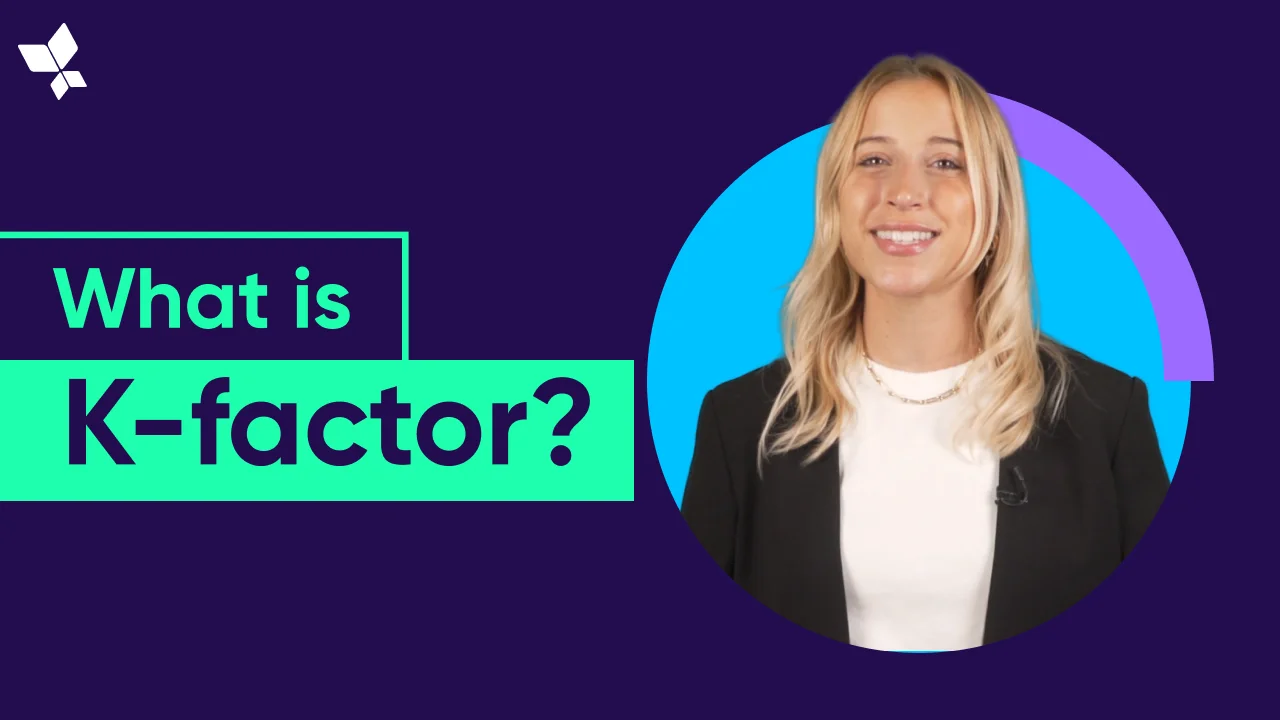
K-factor
In mobile marketing, K-factor is a metric that defines your app’s virality by factoring in how many new users the average existing user introduces to your app.
What is K-factor?
As the term suggests, the terminology is borrowed from epidemiology, where you can think of the K-factor as the combination of the “contagiousness” of your app (how many new users are “infected” by an existing customer through an invite), with the effectiveness of each invite (its associated conversion rate).
In other words, the higher your K-factor is, the more people are spreading the good word about your app.

How to calculate the K-factor?
Although there are quite a few formulas out there, the most common one is:
i * c = k
i = number of app invites sent per customer. For example, if each new customer invites five friends, then i = 5.
c = conversion of each invite. For example, if one in five invitees converts into a new customer, then c = 0.2.
Putting the two together, the K-factor here would be = i * c, or 5 * 0.2 = 1.
Let’s expand on this a bit.
We have a dating app and decided to incentivize our loyal users to invite their friends, by offering them 10% off on their monthly subscription. Let’s say each user invites one friend on average (i = 1), and every third invitee has successfully registered (c = ⅓). In this case, the K-factor = 1 * ⅓ = 33.3%.
Assuming all goes well, this would mean that if our dating app initially had 100 active users, that number would soon grow to 133, and then 178, and so on. According to this model, after 33 invitation cycles, our number of active users will exceed one million. Not bad, huh?
Bridging the gap between organic users and UA campaigns
In the real world, however, things are not that simple.
Sometimes it could be challenging to get a true value for K-factor because it might be difficult to pinpoint exactly why an organic user installed your app.
Word-of-mouth marketing is awesome, but very hard to measure. On top of that, not all apps promote referral programs, and not all users embrace referral programs when being offered.
Apply the K-factor to your user acquisition (UA) campaigns, however, and it can be easier to understand where your organic users are coming from:
Let’s say that our dating app has almost zero daily organic downloads in a certain region. We go ahead and purchase 10,000 users, and find that after a certain period of time our user base has grown to 12,000 users. Providing that we actively promote a referral program, this could mean that 2,000 new users came as an indirect result of our paid UA campaign, and that our K-factor here is 1.2.
There seems to be some confusion, however, between K-factor to “organic multipliers” or “organic uplift”, and although these two concepts partially overlap, they’re not exactly the same.
Why is it important to measure your K-factor?
Think of it as the icing on your UA investment cake. The K-factor helps you understand how well your non-organic growth affects your organic growth, and can help you spend more efficiently on UA campaigns.
A successful UA campaign could mean climbing up the App Store charts, improving likelihood for organic user exposure, but it could also mean more users will spread news of your app through word of mouth and referral programs.
Both scenarios will result in a positive return on investment (ROI) and a higher K-factor.
Another advantage for keeping a finger on the pulse of your K-factor, is the ability to have better insight into the effectiveness of your app’s built-in sharing capabilities, and the most effective incentives your existing users respond to before recommending your app to their friends.
How do you know if your K-factor is good?
Any K-factor higher than 1, even by a tiny fraction, is evidence of exponential growth and is considered viral.
That being said, it’s important to keep in mind that true viral growth is very rare.
On the not so sunny side of the spectrum, having a K-factor equal to one means you’re in a steady state, and are neither growing nor declining. Below a K-factor of one means your app’s virality is in exponential decline.
What’s another way of looking at a good K-factor? The virality of your app needs to cover the churn of your users.
In other words:
- If your K-factor outnumbers your churn rate, this means more users come than go, and your app is exponential growth.
- If your K-factor equals your churn rate, this means your app’s virality compensates its churn.
- If your K-factor is out beaten by your churn rate, this means your app’s audience is on a gradual decline.

How can you boost your app’s K-factor?
1. Enhance your shareability
The most viral products are those that only work once shared.
Think of Skype, which in its early days only worked if you got your friends to use it too. Put some thought into making your app more social, by rewarding users for sharing their progress, score or experience with their friends or co-workers.
You can plant traffic drivers into the flow of your app, like options to “share high score” with friends, or incentivize users to “invite a friend to play.”
A good way to strengthen this strategy would be to offer these calls to action during key moments: To give an example from the gaming world, if a user just lost a life, you can offer them the chance to gain three more by inviting a friend to install your app.
Another efficient way to increase shareability is to leverage viral platforms like Facebook, which have built-in features to let your users’ friends know what apps they’re using. The wall and status updates are both prime and super effective viral real estate.
Bottom line is – don’t overly complicate your shareability.
Get rid of multiple permissions or additional logins to make the sharing process as simple and as hassle-free as possible.
2. Listen, learn, test & optimize – tap into proven growth hacks
The market is full of insightful resources around effective referral programs and viral marketing tactics. To name a few:
- How Referrals Built The $10 Billion Dropbox Empire, by Visakan Veerasamy for Referral Candy
- The Best Referral Program Examples, by Brandon Gains at Referral SaaSquatch
- Customer Acquisition & Monetization, by David Skok for For Entrepreneurs
- ‘Startup Growth Engines: Case Studies of How Today’s Most Successful Startups Unlock Extraordinary Growth’, by Sean Ellis & Morgan Brown
Once you’ve started testing around different methods, use A/B testing to figure out which approaches and creatives are getting you the highest conversion rates and biggest impact.
3. Incentivize your users
Rewarding user action with in-app currency, discounts, or other bonuses can be very impactful.
Monitoring and measuring user-encouraged sign-ups after redeeming a special code or referral number, will also allow you to identify your top converting users, and reward them accordingly.
4. Incentivize your users’ friends
Existing users are more likely to recommend an app to their friends if there’s also a reward for the invitee.
When offering new users an install reward, be sure to extend a meaningful and relevant gesture. In other words, new users are not likely to understand the value of 10 in-app coins, but an exciting premium feature or a discount for in-app purchases should pique their interest more.
5. Make sure you have a great app
This may sound obvious, but it’s really not. Virality is not a simple marketing strategy that can be executed in silo, and has to be built into your app right from the get-go. It’s an actual function that needs to be thought through by your product designers, and brought to life by your engineers.
Your users would be much more inclined to share your app with their friends if it offers a smooth, joyful and value-packed user experience, so be sure to make your app shine!
6. Target the right audience
Once you begin to understand your K-factor, you can leverage this information to optimize your UA spend. Knowing what kind of users drive your K-factor the most will enable you to adjust your campaign spend, and shift your focus towards high-scoring segments.
Going back to our dating app, let’s say that the numbers indicate that users from the UK show an average K-factor of 1.8 (group A), whereas users from Germany show a K-factor of 1.2 (group B). Our UA ad spend would be best directed at group A, as it’s likely to bring in more organic users.
Key takeaways
- The K-factor helps you understand how well your non-organic growth affects your organic growth, and how to spend more efficiently on UA campaigns.
- The K-factor gives you better insight into the effectiveness of your app’s built-in sharing capabilities, and the most effective incentives your existing users respond to before recommending your app to their friends.
- Driving your K-factor upward is not a sprint, and requires cross-department strategic planning and execution to ensure success.
- Chasing virality blindly without investing in retention could bring your app to rapidly decline. A good K-factor means the virality of your app should always cover the churn of your users.
- Find ways to increase your app’s shareability, invest time into learning more about proven growth hacks, come up with exciting referral programs, and ensure your user experience is awesome (because a poor one won’t help your app go viral even if you pour every single cent on it).
- And lastly, leverage your K-factor data to hone your UA campaigns. This will help you meet your ROI expectations and drive an even higher K-factor.
Good luck!




